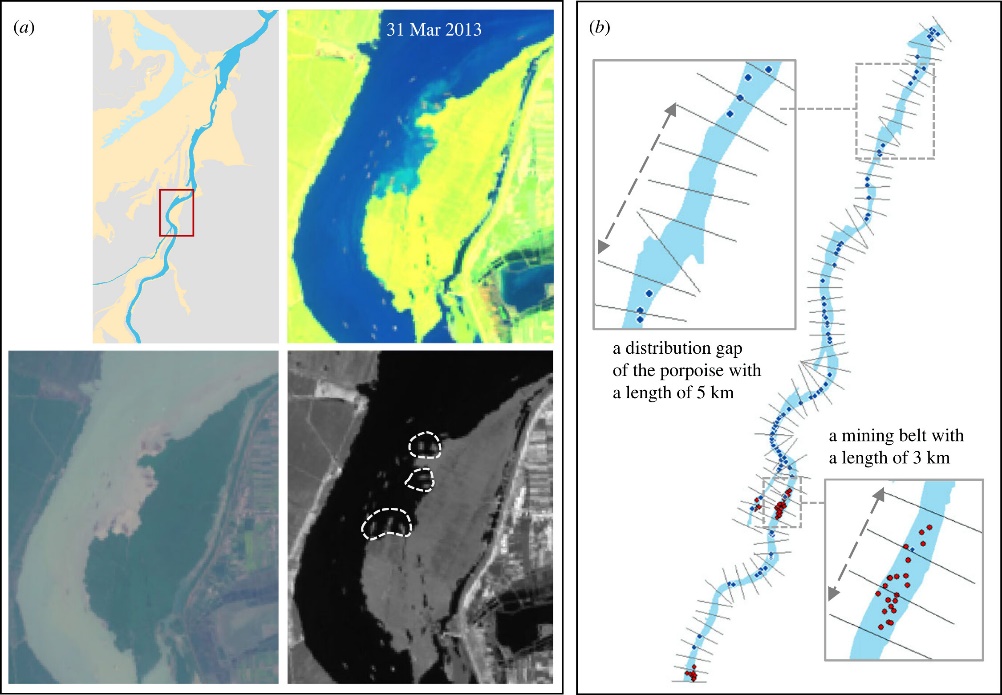不可持续的采砂对生态的影响:从一种极度濒危的淡水鲸鱼上吸取的紧迫教训
Ecological impacts of unsustainable sand mining:
urgent lessons learned from a critically endangered freshwater cetacean
作者:Yi Han, Wenjing Xu, Jiajia Liu, Xinqiao Zhang, Kexiong Wang, Ding Wang, Zhigang Mei
期刊:Proceedings of the Royal Society B
Sand mining, which has tripled in the last two decades, is an emerging concern for global biodiversity. However, the paucity of sand mining data worldwide prevents understanding the extent of sand mining impacts and how it affects wildlife populations and ecosystems, which is critical for timely mitigation and conservation actions. Integrating remote sensing and field surveys over 14 years, we investigated mining impacts on the critically endangered Yangtze finless porpoise (Neophocaena asiaeorientalis asiaeorientalis) in Dongting Lake, China. We found that sand mining presented a consistent, widespread disturbance in Dongting Lake. Porpoises strongly avoided mining sites, especially those of higher mining intensity. The extensive sand mining significantly contracted the porpoise's range and restricted their habitat use in the lake. Water traffic for sand transportation further blocked the species's river–lake movements, affecting the population connectivity. In addition, mining-induced loss of near-shore habitats, a critical foraging and nursery ground for the porpoise, occurred in nearly 70% of the water channels of our study region. Our findings provide the first empirical evidence of the impacts of unregulated sand extractions on species distribution. Our spatio-temporally explicit approach and findings support regulation and conservation, yielding broader implications for sustainable sand mining worldwide.

Figure 1. Identification and illustration of sand mining activities. (a) The identification process of sand dredgers. The four panels from left to right, top to bottom show the location of the scene (obtained from the Landsat 8 OLI on 31 March 2013), and the scene displayed in a false-colour composite (red, NIR & SWIR-1), the true-colour composite (Red, Green & Blue), and the SWIR-2 band, respectively. Identified sand dredgers shown as bright dots are outlined for further classification. (b) Sightings of the porpoise in the 2006 survey (blue dots) and sand dredgers corresponding to the survey (red dots). Data were assigned to 1 km water segments. (Online version in colour.)
在过去二十年里,采砂量增加了两倍,成为全球生物多样性面临的新兴问题。然而,由于全球范围内采砂数据的缺乏,采砂的影响程度及其对野生动物种群和生态系统的影响无法了解,而这对于及时采取缓解和保护行动至关重要。综合十四年的遥感和实地调查,我们研究了采砂对中国洞庭湖中极度濒危的长江江豚(Neophocaena asiaeorientalis asiaeorientalis)的影响。研究发现,采砂对洞庭湖造成了持续、广泛的干扰。江豚极力避开采矿点,尤其是采矿强度较高的地方。大规模的采砂活动大大缩小了江豚的活动范围,限制了它们在湖中的栖息地利用。运沙的水上交通进一步阻碍了该物种在长江与洞庭湖之间的活动,影响了种群的连通性。此外,近岸栖息地是江豚重要的觅食和育儿场所,但调查区域近70%的水道都出现了采砂引起的近岸栖息地丧失。以上研究结果为不受管制的采砂活动对物种分布的影响提供了首例实验论据。研究采用的时空数据可视化方法和研究结果为监管和保护提供了支持,为世界范围内的可持续采砂带来了更广泛的影响。








